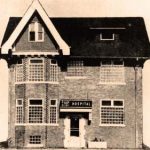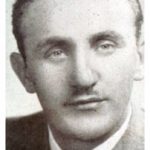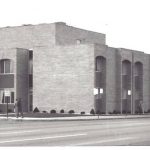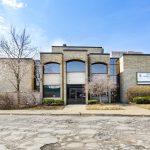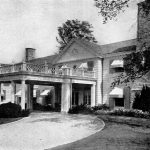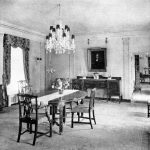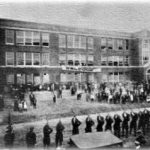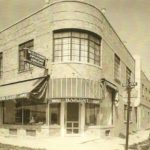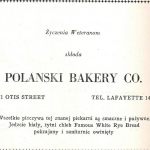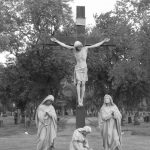A History of Zieger Osteopathic Hospital
4244 Livernois, Detroit, Michigan 48210
Zieger Osteopathic Hospital was founded by Allen Zieger, D.O., a Detroit physician. He was married to Edna Zieger.
Allen Zieger was born on March 1, 1910, in Poland. According to the 1940 U.S. Census, Edna was born in New York. In 1940, the couple was renting a residence at 6443 Michigan Avenue, between Gilbert and Cicotte, which would have been almost across the street from the Senate Theater. Dr. Zieger was 30 years old, and Edna was 29. They had a two-year-old daughter named Carol.
The Census report lists Dr. Zieger as a self-employed osteopathic physician in private practice, working 45 hours per week. He had completed four years of college. He was a naturalized U.S. citizen.
According to World War II draft records, Dr. Zieger registered for the draft on October 16, 1940, in Detroit. At the time, he weighed 160 pounds and was 5’6” tall. He had blue eyes and brown hair and a light complexion.
During World War II, osteopathic physicians (D.O.’s) did not enjoy the same privileges as medical doctors (M.D.’s). Osteopathic physicians traditionally have been proponents of painless treatments, with a practice focused more on the theory of the musculoskeletal system. Because of differences in their medical practices, during World War II, osteopathic physicians were neither assigned to the military nor given privileges in the same hospitals as medical doctors.
At the same time, the War created a shortage of doctors as well as a shortage of hospital beds in Detroit, as field hospitals had to be set up on the front to care for the wounded. Thus, in 1944, Dr. Zieger opened up his own hospital in Detroit, which he named Zieger Hospital Clinic. Dr. Zieger launched his hospital in a rooming house that he purchased and transformed into a 20-bed facility.
It can be said that Dr. Zieger was a visionary. The small hospital quickly expanded and became a large structure at 4244 Livernois Avenue, on the east side of Livernois, between Michigan Avenue and Buchanan. The hospital became a renowned osteopathic training institution and was a mainstay in the area, serving thousands of residents in the adjacent neighborhoods for several decades.
On the other side of Livernois Avenue, across the street from the main hospital, Dr. Zieger oversaw the construction of an auxiliary wing, which housed the hospital’s obstetrics practice. Throughout the ensuing decades, countless babies were delivered by doctors and nurses in that maternity ward. Many Polish Americans who lived in the surrounding neighborhoods of Detroit’s west side were born there, and Zieger Hospital became a household name for an untold number of those residents.
A Society member recalled the days immediately following the birth of his younger sister, who was born at Zieger Hospital in 1965. “I remember we were walking on Livernois, on the Zieger Hospital side, going to the maternity hospital with my dad. My mother had just had our little sister. We were going in to visit her. Then we were walking to the car as my mom was waving good-bye to us from the second floor window of the maternity ward. I remember the smell of the baby lotion.”
Later, he and three of his siblings all had their tonsils removed at Zieger Hospital. “Dr. Sitner and Dr. Uzansky would take our tonsils out in the hospital. A story appeared in the West Side Courier: ‘Four Children in the Same Family Had Their Tonsils Out at the Same Time.’ I was about 10 years old at the time.”
And the memories never left. “Later, after I graduated from Chadsey High School in the summer of ’79, every day I drove past Zieger Hospital on my way to my job at the bakery. I would drive up Barlum to Livernois and take Livernois past Zieger Hospital, down to Otis and Wesson, to Rosen’s Bakery. To this day, I can remember the smell of the baby lotion.”
By the 1970s, the hospital was still operating. It is unknown whether the hospital ever served as a major trauma center, but in the 1970s, it was not serving as such. During those years, severely injured patients were dispatched to the area’s major trauma centers, such as Receiving, Henry Ford, and Providence Hospitals.
Both hospital buildings on Livernois Avenue were eventually razed. As one blogger has written, “A lot of history and memories went with them.”
When Zieger Hospital was nearing its final days of operation, it is known from oral history that patients and employees were relocated to Dearborn Medical Centre Hospital, Inc., at 10151 Michigan Avenue, just west of Wyoming, in Dearborn. The hospital originally had opened in 1941 at 10149 Michigan Avenue under the name Dearborn Industrial and General Hospital, as an expansion to the Dearborn Medical Center clinic. The facility continued to expand to encompass 10149–10151 Michigan Avenue, and by the 1950s, it was known as the Dearborn Medical Centre Hospital.
Some of Zieger Hospital’s nursing staff were among those employees who were transferred to the Dearborn Medical Centre Hospital when Zieger Hospital closed. In the 1970s, Dearborn Medical Centre Hospital had a department that specialized in performing outpatient gastric procedures.
At that time, in the early 1970s, a renovation and expansion project took place along the encompassing stretch of Michigan Avenue. By 1984, the hospital was operating as a full family practice clinic. Its practice included cardiology, diagnostic ultrasound, gastroenterology, general geriatric medicine, general obstetrics and gynecology, general pediatric medicine, general surgery, industrial medicine, internal medicine, nuclear medicine, pulmonary disease, and radiology. It also had a laboratory, a pharmacy, a 24-hour emergency room, and a surgical center where general surgery was performed.
In 1986, the hospital was procured by the Oakwood Health Services Corporation. The hospital may still have been operating up until very recently. Although the building is still standing as of 2020, it appears to be vacant, and the exact date of closure is unknown.
In the 1960s, Dr. Zieger had purchased 15 acres of land on Grand River Avenue in Farmington Hills, Michigan—at the time, quite a distance from Livernois and Michigan Avenue—and, with $300,000 in loans from his fellow physicians, he built a brand new, 200-bed hospital on the site. In 1965, Botsford General Hospital opened, with Dr. Zieger serving as its CEO—a position he would hold until his death in 1984.
Dr. Zieger and his wife enjoyed an elegant lifestyle and reveled in the fruits of his labor. In the early 20th century, several of Detroit’s automotive pioneers owned summer homes on Grosse Ile, the largest of over 20 islands located in the Detroit River. A mansion on the island that previously had served as the summer residence of William A. Fisher of Fisher Body fame became Dr. and Mrs. Zieger’s home in the 1950s. To paint a picture of just how luxurious the home must have been, the driveway itself featured a circle in the middle of it that bore a giant “Z” in the center, for Zieger—a symbol of the doctor’s prestige and success.
The home featured a huge flower garden, a swimming pool building with dressing rooms and Pewabic tile ornamentation and vaulted ceilings, staff quarters, a vaulted lounge, a grand entrance hall, a formal dining room, a Pewabic tiled fireplace, and much more, including a grand piano in the front anteroom and underground passageways leading from the basement to the field across the road. It is said that there were horses that roamed in the field next to a small house—perhaps a guest house or a field house used for storage.
Dr. and Mrs. Zieger held lavish parties at this home during the 1950s. During dinner parties, a hired professional pianist performed on the grand piano for the entertainment of their guests. They had a private cook who, it is said, used to manually trap small fish in nets in the Detroit River for use in his culinary creations.
In the early 1960s, Dr. Zieger had the mansion torn down but kept the pool house. He renovated the boat house, which was situated off what is said to be the longest boat dock in Michigan, and he and Mrs. Zieger lived there, looking out over the Detroit River from windows that lined the sides of the home. Dr. Zieger eventually sold the pool house and the rest of the property.
On the site of Botsford Hospital once sat the historic Botsford Inn. It was built in 1836 by Allen and Orrin Westin as a residence. In 1841, Stephen Jennings converted it to a roadside tavern, which became known as the Sixteen Mile House. In 1860, Milton Botsford bought the building, which had become the last and a popular stagecoach stop for travelers along Grand River Avenue between Detroit and Lansing.
The inn became a fashionable dancing venue, and Henry Ford and his future wife Clara were among those who went there to dance. Ford apparently loved the inn because in 1924, he purchased the building along with its surrounding acreage. He renovated the inn, uplifting its façade by embellishing it with Victorian architectural features. Ford enjoyed the site as his private hideaway for several years, after which it was opened to the public.
Following Henry Ford’s death in 1947, the Anhut family bought the inn in 1951. Throughout the succeeding years, hundreds of people from the surrounding area enjoyed the ambiance of the historic lodge, eating brunch in its grand dining room and attending special events at what was one of Michigan’s oldest inns. The Anhuts ran the Botsford Inn until 1999.
On September 25, 2007, Botsford Hospital had the non-historic portion of the inn demolished to make way for the construction of a state-of-the-art cancer center. The historic portion of the inn was restored to reflect the inn’s Ford-era exterior. A historic barn that Henry Ford had moved onto the property was relocated to another venue in Farmington Hills. Some of the artifacts from the Botsford Inn were preserved for use in the new cancer center.
Botsford Hospital remained an independent hospital until 2014, when it became part of the Beaumont Health System. The tradition of osteopathic training fostered by Dr. Zieger continues today in the form of a partnership between Beaumont Farmington Hills and Michigan State University College of Osteopathic Medicine.
Sources:
- https://www.ancestry.com
- http://farmingtonvoice.com/farmington-hills-hospital-property-has-rich-history/
- https://www.atdetroit.net/forum/messages/125438/128672.html?1203898987
- https://en.wikipedia.org/wiki/Beaumont_Hospital,_Farmington_Hills
- https://www.beaumont.org/about-us/history/digging-for-botsford-s-roots
- http://migenweb.org/wayne/wayhospitals.htm
- http://halfpuddinghalfsauce.blogspot.com/2015/08/summer-residence-of-mr-william-fisher.html
- https://www.detroityes.com/mb/showthread.php?2406-Closed-Hospitals/page3
- https://www.seniorliving.org/history/1809-1930-history-hospitals-michigan/
- https://historicdetroit.org/buildings/st-marys-hospital
- https://detroithistorical.pastperfectonline.com/bysearchterm?keyword=Art+Centre+Hospital
- https://patch.com/michigan/farmington-mi/the-departed-historic-buildings-of-the-botsford-inn
- https://thedhm.com/medical-exhibit/hospitals/
- https://www.youtube.com/watch?v=GlIlVutXlBE
- Lawrence A. Choraszewski. Telephone conversation. (West Bloomfield, MI: May 4, 2020)
- Mason Christensen, Archivist, Dearborn Historical Museum. Email. (May 5, 2020)
Photos:
- Zieger Clinic Hospital, Detroit, Michigan, ca. 1944
Source: https://farmingtonvoice.com/farmington-hills-hospital-property-has-rich-history/ - Allen Zieger, D.O., ca. 1944
Source: https://farmingtonvoice.com/farmington-hills-hospital-property-has-rich-history/ - Dearborn Medical Centre Hospital, 10149-10151 Michigan Avenue, Dearborn, Michigan, 1971
Source: https://thedhm.com/medical-exhibit/hospitals/ - Oakwood Healthcare Center, 10151 Michigan Avenue, Dearborn, 2020
Source: https://www.loopnet.com/Listing/10151-Michigan-Ave-Dearborn-MI/15991049/ - Dr. and Mrs. Zieger’s Home, 19013 Park Lane, Grosse Ile, Michigan, ca. 1950
Source: https://halfpuddinghalfsauce.blogspot.com/2015/08/summer-residence-of-mr-william-fisher.html - Dining Room of Dr. and Mrs. Zieger’s Home, 19013 Park Lane, Grosse Ile, Michigan, ca. 1950
Source: https://halfpuddinghalfsauce.blogspot.com/2015/08/summer-residence-of-mr-william-fisher.html - Botsford Inn, 28000 Grand River Avenue, Farmington, Michigan, 2014
Source: www.bing.com/images
